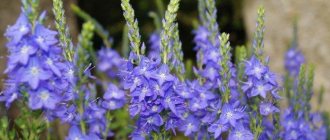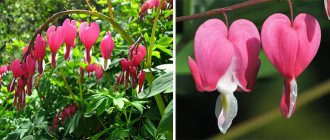Author: Elena N. https://floristics.info/ru/index.php?option=com_contact&view=contact&id=19 Category: Garden plants Published: January 13, 2019Last edits: January 20, 2021
- When to plant
- Growing conditions
- Gigantic
The history of snapdragon, or antirrinum, goes back a long way: its origins are poetically described in ancient Greek myths. The decorative qualities of snapdragon are beyond praise. It is presented in varieties of different heights and all kinds of colors: you can grow antirrinum as a border, as a solo plant, and also in mixed plantings, combining it with other garden crops.
In our article we will tell you about:
- what varieties and varieties of snapdragon are represented in culture;
- how to grow antirrinum in the garden;
- how to care for it;
- how and when to collect snapdragon seeds.
Planting and caring for snapdragons
- Planting: in warm climates, sow seeds in the ground in April or before winter. Seeds are sown for seedlings in mid-March; seedlings are planted in open ground closer to mid-May or early April.
- Flowering: from mid-summer to late autumn.
- Lighting: bright sunlight or partial shade.
- Soil: well-fertilized, breathable, light loamy soil with a pH of 6.0-7.0, cultivated to a depth of 30-40 cm.
- Watering: only in the mornings during dry seasons, plentiful.
- Fertilizing: 2-3 times before flowering with complete mineral fertilizer.
- Reproduction: seeds and cuttings.
- Pests: aphids, root-knot nematodes, spider mites, cutworms, thrips, slugs.
- Diseases: late blight, fusarium, verticillium, blackleg, septoria, sclerotinia and downy mildew.
Read more about growing snapdragons below.
Snapdragon flowers or antirrhinum, are a genus of herbaceous plants of the Plantain family, covering about 50 species of perennials, including climbing ones, common in the warm zones of the Earth, but mostly in North America. The Russians call this plant “dogs,” the British call it “snapdragon” (biting dragon), the French call it “wolf’s mouth,” and the Ukrainians call it “mouth.” From the Greek, the name “antirrinum” is translated as “nose-like”, “nose-like”.
An ancient Greek myth tells about the first labor of Hercules, when he defeated the Nemean lion, famous for its ferocity and invulnerability. The goddess Flora presented Hercules with a beautiful flower she created in honor of his victory, which she called “snapdragon.” Since then, it has become a tradition in Greece to give snapdragons to heroes. The snapdragon flower has been in culture for about five hundred years, and breeding work was started by German scientists in the 19th century, and today about 1000 varieties of snapdragon are grown in the gardens of the planet, and the most interesting thing is that the basis for this variety of forms and hybrids was a single species – Antirrhinum majus.
- Blackleg - 4 conditions, the fulfillment of which will help you forget about this disease on seedlings forever
Autumn care and seed collection
Planting material for propagation of antirrhinum ripens unevenly: first, seed boxes are formed on the lower buds. When the boxes dry out and turn brown, you need to collect most of the material, carefully open the fruits, and take out small elements. Dried seed is stored for up to four years while maintaining germination.
Snapdragon reproduces well by self-sowing. To preserve the properties of a certain variety, other varieties should not grow within a radius of about 90-100 m. Cross pollination often changes the color of the petals of new plants appearing in the same area the following year.
Botanical description
The snapdragon plant is a subshrub or herbaceous plant with straight, branched green, finely grooved stems from 15 cm to one meter in height, forming pyramidal bushes. The upper leaves of the snapdragon are alternate, the lower ones are opposite, their shape is elongated oval or lanceolate, the color is from light green to dark green with red veins.
How to sow calendula and how to care for it
The flowers are fragrant, rather large, irregular, two-lipped, depending on the variety, simple or double, collected in spike-shaped inflorescences, and are colored white, yellow, pink, soft fawn, all shades of red, but there are also two-color and even three-color varieties. The fruit is a two-locular multi-seeded capsule, with 5,000 to 8,000 seeds in one gram. Flowering of snapdragon usually begins in June and ends with frost.
Most often, the perennial snapdragon in nature is grown in gardening as an annual plant, but with good care and favorable conditions, the cold-resistant snapdragon can successfully overwinter in the garden and bloom more beautifully the next year. In garden design, antirrhinum is grown as a border plant, although snapdragons look great both in a flowerbed and planted in groups against a green lawn. Snapdragons are often used to decorate balconies and terraces.
Of particular interest to gardeners today are ampelous forms of snapdragons, which can be grown in hanging structures to decorate terraces and galleries.
In the photo: Snapdragon flowering in the garden
Origin and appearance of the plant
Perennial flowering forms in the wild were found on the American continent, and then distributed in Europe and Russia.
These are pyramidal-shaped subshrubs with simple or double flowers of irregular shape, collected in racemes and located on high peduncles.
The snapdragon variety is an annual plant native to Southern Europe (France, Spain, Malta), North Africa (Libya, Tunisia, Morocco) and East Asia (Turkey, Cyprus). In these countries, the crop is widely used for landscaping park areas and city streets.
Snapdragon in outdoor landscaping
Wild snapdragon (field)
Wild snapdragon (Wild flax, Toadflax) is a perennial herbaceous plant, reaching a height of up to 60 centimeters, with a straight, simple or slightly branched stem, on which lanceolate-linear leaves are very densely planted.
Stems of various shapes may have grooves on their surface. In this antirrhinum large, the tips of the shoots are densely covered with glandular hairs. The flowers open at different times. Usually the upper flowers in the cluster open when the lower ones have already withered.
Wildflowers can be yellow, red, blue, purple, mostly with a simple perianth. The fruits are capsules up to 2 cm long with small wrinkled seeds.
The plant is found quite often throughout Russia. It often grows as a weed in abandoned wastelands, fields, slopes, cliffs, along roads, in deciduous and birch forests. It can also be found in garden plots.
Important! Common toadflax is considered a poisonous plant, particularly for cattle.
Growing snapdragons from seeds
Sowing seedlings
Snapdragon reproduces by generative and vegetative methods. Snapdragon seeds retain the ability to germinate for several years. If you live in a warm climate, you can grow snapdragons from seeds, sowing them directly into the ground, and they will sprout in two and a half to three weeks, without any problems surviving even a slight cold snap at night, which is common in spring, but in areas where it is warm occurs gradually, it is better to use the seedling method of growing snapdragons. How to grow snapdragons from seeds using seedlings? This process is neither complicated nor labor-intensive.
So, we sow snapdragons: at the beginning of March, pour coarse sand into bowls with a diameter of at least 10 cm with drainage holes, and on top of the sand - compost soil mixed with sand, compact it, level it, sprinkle it with water from a sprayer and distribute it over its surface in the same way seeds mixed with sand, which we then cover on top with a thin layer of the same substrate, moisten it with a fine spray bottle and cover the sowing bowl with glass.
Conditions for growing healthy asters
Every day we remove condensation from the glass, let the crops breathe and, if necessary, moisten the soil with a sprayer. At a temperature of 23 ºC and moderate substrate humidity, sprouts will appear in a couple of weeks. As soon as this happens, move the bowl to a bright, non-sunny place so that they do not stretch out, and as soon as the emergence of seedlings becomes widespread (in 3-4 days), remove the glass.
In the photo: Growing snapdragon from seeds
Seedling care
The seedlings will grow slowly at first, and your task during this period is to ensure proper soil moisture, watering the soil in the morning so that there is enough moisture, but not in excess, as this can lead to seedlings becoming infected with blackleg. “Fallen” sprouts should be removed with tweezers, and the place where they grew should be powdered with crushed coal or sprinkled with a small amount of calcined and cooled river sand. After a pair of true - not cotyledon - leaves appear, the seedlings dive into a container or box, placing them so that they grow freely.
You can plant seedlings in individual pots or, for example, plant three sprouts in larger pots.
Place the picked seedlings in a bright place, protecting them from direct sunlight, and begin to gradually accustom them to the environment and temperature in which they will find themselves after transplanting into open ground: open the window slightly during the day for a while, but make sure that the seedlings do not found herself in a draft. The central shoot of each seedling after the development of 4-5 leaves must be pinched to enhance tillering, but if the side shoots are also growing too actively, pinch them too.
Pictured: Red snapdragon
Growing seedlings
The seeds of the plant can be sown directly into open ground. They will emerge in two or three weeks and will calmly survive minor cold snaps. But this method of planting snapdragons is only suitable for warm areas. In the middle zone and regions where there are still frosts in May, it is better to grow snapdragons in seedlings.
The seed planting procedure is carried out in March:
- Seedling containers are prepared, the diameter of which must be at least 10 cm.
- The bottom of the containers is filled with coarse sand, on top of which compost soil mixed with sand is poured.
- The soil is moistened with warm water from a sprayer.
- Seeds are mixed with sand and distributed over the surface of a moist substrate.
- Using a spray bottle, carefully moisten the plantings and cover them with polyethylene or glass.
Caring for crops consists of keeping them at an air temperature of +23 degrees, timely moistening the soil and ventilating it daily.
Under favorable conditions, seedlings will appear within three to four days. It will be necessary to remove the polyethylene and place the seedling containers in a bright place where there is no direct and burning sunlight.
Planting snapdragons
When to plant
At the end of May - beginning of June, grown, strengthened and hardened seedlings are planted in open ground. And don’t be afraid of the last night’s cold snaps: your young “lion cubs” will survive them calmly. The site for growing snapdragons can be either sunny or slightly shaded, but must be well drained and protected from strong winds. The soil needs to be light and nutritious. The best soil for snapdragons is a mixture of sand, compost and peat in approximately equal proportions. The optimal soil pH for snapdragon is pH 6-8.
- How not to grow onions in sawdust for greenery - common misconceptions
In the photo: Snapdragon in a flowerbed
How to plant
Planting snapdragon flowers is carried out according to the following scheme: tall varieties are planted at a distance of 40-50 cm from each other, medium-sized varieties - at a distance of 30 cm, low-growing varieties - after 20 cm, dwarf varieties - after 15 cm. As soon as the snapdragon takes root, it begins to grow very grow quickly and turn into a lush flowering bush. You should know that snapdragons are planted in well-moistened soil.
Care during and after flowering
To preserve the high decorativeness of the snapdragon:
- moisten the soil in a timely manner;
- periodically feed with phosphorus-potassium compounds;
- remove weeds;
- loosen the ground;
- add mulch (peat or sawdust) to maintain soil moisture;
- do not allow wilted petals to remain on the inflorescence for a long time.
Snapdragon Care
Growing conditions
This plant is unpretentious and needs only what any garden flower needs: watering, loosening the soil, removing weeds and fertilizing. You will only have to water the plants in dry times when there is no rain, but not at night. The next day after watering or the same day in the evening, it is advisable to loosen the soil and weed out the weeds. It is advisable to tie tall varieties of snapdragon to a support. It is better to pick off wilted flowers so that the plant does not waste energy on them.
If you want to get snapdragon to bloom for a long time, do not let it set seeds, remove the flower shoot as soon as the last flowers have withered. You need to cut off the peduncle under the lowest flower, then new arrows and new flowers will appear.
As soon as the plant takes root in the ground after planting, it needs to be fed with nitrophoska and organic matter, the second feeding is carried out when the snapdragon begins to form buds, and in this case, a urea solution, potassium sulfate and superphosphate are used at the rate of one tablespoon of each ingredient per 10 liters water.
In the photo: Pink flowers of antirrinum
Pests and diseases
Sometimes red rust spots appear on the plant; septoria, black leg, gray or root rot can affect the snapdragon. Diseased specimens should be immediately removed and burned, and the soil in the place where they grew should be treated with an antifungal drug (fungicide).
How to grow sweet peas from seeds - a proven method
Dangerous insect pests include scale insects, fly larvae, caterpillars and butterflies that lay eggs. It is always easier to take preventive measures than to treat an already existing disease or expel insects that have settled in flowers, so follow the recommendations for caring for the plant, promptly remove diseased or pest-affected specimens, do not allow plants to grow too close to each other, maintain moderation in moistening the area, by watering flowers at the root, and not at the leaves, and the snapdragon will not be afraid of either diseases or insects.
In the photo: Growing snapdragons
Care after flowering
Snapdragons can bloom until autumn frosts, but when autumn sets in, cut the snapdragons, if you grow them as a perennial plant, so short that the rest of the stem rises above the ground 5-8 cm high, and cover the area with peat with sawdust or dry foliage - mulch will help plants survive the winter. If you are growing an annual snapdragon, then to avoid self-seeding during the entire flowering period, pick off the wilted flowers in a timely manner, and when all the flowers on the arrow have faded, cut the peduncle as low as possible. This must be done in order to prevent the seeds from ripening and falling on the ground. When deep autumn arrives, dig up the area and burn the remains of the plants to destroy the pests that have settled in them.
In the photo: Snapdragon flower
Features of care
Snapdragon is an easy-to-care plant. But certain nuances should still be taken into account.
Watering
Antirrinum needs regular but moderate watering. It is especially important to moisten the soil immediately after planting seedlings, as well as in the summer heat. After each watering, the soil around the snapdragon needs to be loosened. You also need to promptly remove weeds around.
For mulching, grass clippings, nut shells, and wood chips are suitable.
Top dressing
Before applying fertilizer, you need to make sure that the plants have adapted to the new location. As soon as the seedlings begin to grow, they can be fed with mineral fertilizers. Also, crops must be fed after flowering.
Care during and after flowering
It is better to remove buds that have bloomed immediately. This procedure will prolong the flowering process and make the plants look neat. If the antirrinum stems are tall, they can be tied up. Thanks to the support, the flower stalks will stay straight and will not bend under the weight of the buds.
How and when to collect seeds
The seeds of most garden plants are collected when they are fully ripe. But snapdragon seeds need to be harvested in the incomplete ripeness phase, so that they can then be ripened in a dry room with good ventilation. Collection is carried out in a long paper bag, as for a baguette. They start collecting seeds when the fruits on the lower part of the peduncle ripen: the upper part of the peduncle, on which the fruits are still green, is cut off and thrown away, and a paper bag is put on the remaining part of the flower shoot, tied with a thread below the fruits and the shoot below the bandage is cut off. The inverted bag is hung in a warm, dry room and waiting for the ripened seeds to pour out of the boxes into the bag. Then they are placed in cardboard boxes and stored at a temperature of +3-5 ºC, protected from possible moisture.
In the photo: Antirrhinum flower
Protection from pests and diseases
A common problem is rotting of the root collar. Blackleg disease develops when the soil becomes waterlogged. Snapdragon loves a moderately moist substrate, but it is unacceptable to flood the plantings , especially in the absence of heat. To combat rot, the drug Hom, Fundazol is used.
Snapdragon also faces other diseases:
- gray rot;
- fusarium;
- rust.
The main cause of problems is excessive watering. Sometimes plants become infected from other species planted nearby in a group composition.
What to do:
- remove infected instances;
- treat the soil with fungicides: Topaz, Skor, Fundazol;
- eliminate the factors against which diseases develop;
- burn the excavated specimens in another area to completely destroy the pathogens.
Many gardeners are concerned about pests of garden flowers. Snapdragons are often attacked by aphids, caterpillars, scale insects, and midges. What to do when they appear? What drugs effectively kill insects and ticks?
It is useful to take note of the advice of experienced flower growers:
- inspect the plantings more often;
- when identifying harmful insects, collect large specimens (for example, caterpillars);
- Some types of pests (female scale insects) are firmly attached to the leaves, and you can lose a lot of time outside before you can remove most of the parasitic insects. In this case, it is easier to remove a plant on which a large colony of scale insects has appeared from the flower garden so that the pests do not move to neighboring bushes;
- Insecticides are used to kill parasites. Treatment with the following drugs gives a good effect: Actellik, Fitoverm, Mospilan, Aktara, Confidor Maxi.
Types and varieties of snapdragon
Today in professional floriculture there are several classifications of snapdragons, and the most common of them is based on plant height. According to this criterion, varieties are divided into five groups:
Gigantic
The height is from 90 to 130 cm. The central shoot of plants of this group is much higher than the second-order shoots; there are no third-order shoots. Varieties: Arthur - cherry color, 90-95 cm high, F1 red XL and F1 pink XL, 110 cm high, respectively red and pink.
High
From 60 to 90 cm, grown for cutting or as a vertical accent in mixborders or groups. The side shoots are much lower than the central one. When cut, tall snapdragon lasts up to a week or longer; the most fragrant varieties are those with yellow shades. Popular varieties: Anna German - soft pink snapdragon, Canary - a bright yellow variety, a mixture of varieties Madame Butterfly - double snapdragon of different shades and others.
Pictured: Yellow snapdragon
Tall or medium tall
Representatives of the variety reach 40-60 cm in height; they are universal varieties, grown both as flowerbed decorations and for cutting. They are distinguished by strong branching. A characteristic feature of the varieties of this group is also that the central shoot is slightly higher than the side shoots. Varieties: Golden Monarch - yellow, Ruby - bright pink, Lipstick Silver - pinkish-white.
Low
From 25 to 40 cm in height, grown as flowerbed or border flowers. These varieties have many flowering shoots of the second and third order, but the main shoot is at the same level or slightly lower than the shoots of the first order. Varieties: Hobbit, Tip-top, hanging hybrid Lampion.
- The 7 most important things to do in the garden in the fall - how to prepare the garden for winter
In the photo: White snapdragon
Dwarf
15-20 cm in height, flowers for borders, carpet flower beds, rock gardens and ridges. They are also grown as potted plants. These varieties are distinguished by strong branching up to shoots of the third and fourth order, the main shoot is usually lower or at the level of shoots of the second order. Varieties: Sakura Color - a pinkish-white variety with a spot, Candy Showers - an ampelous snapdragon.
In addition to this classification, there is an equally popular classification by Sanderson and Martin for year-round cut varieties, but it is of interest only to those for whom growing snapdragons is not a pleasure or an aesthetic need, but a means of enrichment.
Mr. Summer resident recommends: medicinal properties of snapdragon
Snapdragon is known not only for its beautiful appearance, but also for its medicinal properties. In folk medicine in the East, its decoction is used as:
- antidotes;
- anti-aging agent (combined with lily oil).
Used in the treatment of eyes, gastrointestinal tract, and colds. Ointments and infusions are prepared from antirrinum. Drugs are added when preparing medicinal baths. As a preventive measure, tea is brewed (liver treatment), compresses are used for boils.
In addition to all of the above, there are other recipes. It must be borne in mind that snapdragon is poisonous, so it should be taken only in consultation with a doctor and in the indicated doses. There are a number of contraindications: pregnancy, cardiovascular diseases, hypertension.
Diseases
Sometimes the plant is affected by fungal diseases: fusarium, gray spot, rust.
At the first signs of the disease, spray with 0.2% foundationazole, 1-1.5% suspensions of TMTD (protectant) or Bordeaux mixture.
The plant can be damaged by various types of cutworms. Cutworm caterpillars eat leaves, buds and flowers. Butterflies lay eggs on weeds, from which the caterpillars crawl onto cultivated plants.
Control measures include regular weeding, destruction of weeds, removal of damaged leaves and flowers, double spraying with 0.2% chlorophos.
general information
It's hard to believe, but in nature, snapdragons belong to the herbaceous family Podorozhnikov. This is an ornamental perennial that came to us from warm latitudes, and especially from America. It has been cultivated for more than five centuries, and professional selection began in the nineteenth century in Germany.
Nowadays, over a thousand forms and varieties of snapdragon have been bred, but most often one is immediately recognized by sight - the Greater antirrhinum. Among them there are completely herbaceous species or branched subshrubs. Large fragrant flowers in inflorescences-spikes are notable for their irregular two-lipped shape.
Photo: treespk.ru
How and what to feed snapdragon seedlings?
Feeding snapdragon seedlings
In principle, at the initial stage, snapdragon seedlings can be fed literally once and an ash solution . To prepare it, you will need to take 3 liters of settled water (not from the tap) and dissolve 200 g of wood ash in it. The solution should be allowed to stand for a couple of days and can be used for its intended purpose.
After planting in open ground, seedlings will require stronger fertilizing. superphosphate, potassium sulfate, urea or nitrophoska can be added to the soil . As a rule, 2 tbsp of the above-mentioned products per 10 liters of water is enough to feed young plants. It is advisable to fertilize seedlings twice. The first is 7 days after planting young shoots in the ground.
It will help them take root better and stimulate more intensive growth. Repeated feeding should be done when the plant has 7 full pairs of leaves. It is needed so that the plant can bloom profusely and for a long time. Fertilizer is applied exclusively to the soil. At this stage, foliar feeding is not carried out.
Caring for antirrinum in open ground
Basic care for snapdragons in the flowerbed consists of:
- watering;
- feeding;
- weed removal;
- loosening the soil.
Advice! Fertilize with complex mineral fertilizers, for example, ammophoska or nitroammophoska, notrophoska. Take 2 tbsp. Spoons per 10 liters of water are diluted and watered at the root.
Snapdragon loves moisture, but in drought conditions it quickly recovers after watering. However, do not forget to water the flowers regularly, otherwise the inflorescences will not open well and the flowers will fall off. Watering at the root is best done early in the morning.
Antirrinum blooms in waves until frost, alternating periods of lush flowering with fading when the flowers have faded. Such waves of flowering can continue all summer until frost.
It is recommended to remove faded inflorescences, then they will bloom all summer.
Treatment of snapdragon seeds before sowing: methods, description
Processing snapdragon seeds
Any gardener knows that it is advisable to prepare seeds for sowing. If this is not done, then at least they will take a long time to sprout. The easiest way to prepare seeds is to soak them in a nutrient solution.
Solutions for treating snapdragon seeds:
- Disinfecting solution . Take 500 ml of boiled water, cool it to room temperature, and dissolve potassium permanganate in it. You need to prepare a weak pink solution. If it is very dark, you will simply burn the seeds and they will become unsuitable for further use. Keep the seeds in the solution for about half an hour, then dry them and you can sow them in the soil.
- Nutritious. This solution will help you saturate the seeds with useful substances even before sowing. Thanks to this, they will become stronger and germinate much faster. So, take 2 matchboxes of wood ash and fill it with hot water (500 ml). Let the liquid sit for 48 hours and you can use it for its intended purpose. Strain it, heat it slightly and soak the snapdragon seeds in it. Leave them in the ash solution for 5-7 hours. After this time, remove, dry and sow in the ground.
- Stimulating growth. This method of preparing seeds for sowing will help you significantly speed up their germination. To do this, take the most fleshy aloe leaf, cut it in half and place snapdragon seeds between the two resulting parts. Leave the change on the pulp for 2 hours, and then carefully remove them from there and be sure to dry them (without prior rinsing)
Sowing seeds directly into open ground
In the southern regions, snapdragon seeds can be sown directly in open ground; this is done in early May, when the threat of night frosts has passed and the night temperature does not fall below 10°C.
The flowerbed is laid out in a sunny or slightly shaded area, without wind or drafts.
Antirrinum will fully develop and actively bloom in slightly alkaline, well-drained soils.
Make shallow furrows in the soil at a distance of 30 cm and lay the seeds to a depth of 1-2 cm with an interval of 10 cm between them. Lightly sprinkle with soil and moisten with a spray bottle.
You can cover the flowerbed with a covering material in case of cold weather, which needs to be opened frequently to ventilate the plantings. When the sprouts acquire 4 true leaves, they are thinned out.
What causes snapdragon disease and how to prevent disease?
Diseases of snapdragons
And finally, we would like to introduce you to possible diseases of snapdragons and methods of combating them.
So:
- Blackleg. As a rule, it affects seedlings. Appears due to excessive watering and low temperatures. It manifests itself by the appearance of a dark, deformed place on the stem, just above ground level. can help get rid of the problem . It is advisable to use it according to the instructions described on the packaging.
- Fusarium . The plant stops blooming, turns yellow, and then the stem begins to rot. To prevent the disease from affecting all the flowers on the site, diseased plants must be uprooted and burned. Healthy ones are treated with Zineb or Fundazol .
- Rust. Adult plants are more susceptible to this disease. Initially, brown pustules form on the leaves and stems of flowers, which, without modern treatment, begin to grow, affecting increasingly larger areas. If you miss the right moment, the plant will begin to dry out and die. Treating snapdragon flowers with Bordeaux mixture or copper oxychloride .
Description of antirrinum
Antirrinum is easy to care for, has an unusual flower shape and delights with varied and colorful flowering all summer long.
- The flower grows from 15 to 130 cm in height and forms a pyramidal branched bush.
- Green stems with oval green leaves of different shades.
- The flowers are large, 2-4 cm in diameter, collected in inflorescences.
- The shape of the flower resembles two lips; if you squeeze the bottom of the flower, you get the mouth of a lion. Hence the name.
- Different colors: yellow, pink, burgundy, red, white, multicolor.
- The fruit is in the form of a small box with small seeds.
What soil should I choose and how should I prepare it for sowing snapdragon seeds?
Soil for sowing snapdragon seeds
After you select the right seeds, start preparing the soil and containers for sowing. As for the soil, in this case it is best to choose the most fertile one with a minimum level of acidity. Ideally, it should be disinfected black soil, or a mixture of peat, sand and garden soil.
If you wish, you can buy ready-made soil at any specialized store. It is not particularly advisable to sow snapdragons in heavy, clayey and very acidic soils, as you will end up with weak seedlings that will require additional fertilizing and treatments. So, in order for the soil to be suitable for sowing seeds, it must be disinfected. To do this, you can pour it with a hot solution of potassium permanganate or simply calcine it in the oven.
If you prefer the latter option, then after calcination, be sure to water the soil with a concentrated solution of ash. This will help restore the balance of nutrients. Properly prepared soil should be placed in plastic, glass or wooden containers, which have also been previously disinfected.











